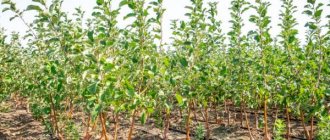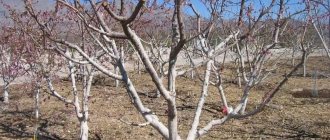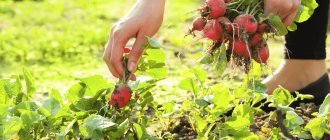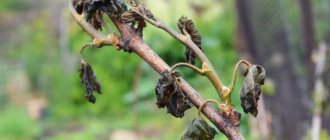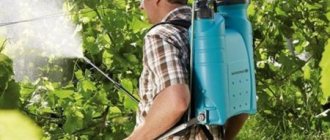Share with friends
If you decide to start viticulture, then you need to know the main rules. Planting grape seedlings in the spring requires certain knowledge and compliance with recommendations. First, before purchasing grapes, carefully study their characteristics: their resistance to pests, diseases, and frost resistance.
Secondly, never plant seedlings mixed with trees. Thirdly, you cannot plant frost-resistant and covering varieties together. These criteria, if violated, will make it difficult to cover the grapes for the winter and further treat the bushes from pests. Remember that with proper care, some varieties can bear fruit even up to 100 years!
Choosing a place to plant grapes
Planting grape seedlings
Taking into account the above rules, the place for planting grape seedlings should be sunny, protected from wind and drafts. It is preferable to choose the southern side, but if there is none on your site, then the sunniest one (the northern side is strictly excluded).
You should not plant grapes near trees that provide dense shade, as well as near the house itself or between buildings. This rule can only be broken if you are growing an ornamental variety and you are not interested in yield.
If you plan to expand your vineyard in the future, allocate more space for it in advance. The distance between bushes, depending on characteristics, growth vigor and other criteria, should be at least 3-4 meters. It is equally important to know the moisture and chemical composition of the soil. If there is excessive moisture, drainage will be necessary.
Soil drainage before planting grapes
Rocky soil in which water does not accumulate is acceptable, and potassium will help the bushes to overwinter better. Iron and magnesium in the soil are needed for photosynthesis, but nitrogen and calcium are needed only in moderate quantities.
It is recommended to plant grapes on plains, mountains and slopes; lowlands are not the most successful and favorable place. The permissible distance between garden trees and grape bushes is 3-4 places. At this distance, the shadow is not terrible, and the trees will additionally protect the bushes from dust, wind and other unfavorable conditions.
How to plant grapes in spring using cuttings
Before we figure out how to properly plant grapes in the spring, let’s consider what gardening material is chosen for these purposes. Gardeners plant vineyards using cuttings or seedlings.
A grape cutting is part of the grapevine's annual growth. This is the cheapest and easiest way to propagate a fruit plant. Cuttings are cut from the most powerful and viable bushes and rooted in the soil of the garden plot. They take root and acclimatize well.
Photo: YouTube / Vyacheslav Radzikovsky: UGC
Let's take a closer look at how to plant grapes with chibouks (cuttings):
- How to prepare grape cuttings for planting in the ground?
Timing for planting grapes - when is best?
You can plant grapes both in spring and autumn - it depends on when you bought the seedlings. There is no definite answer as to when it is best, since the bushes take root equally well in both seasons.
In spring, planting time is quite extended and varies from March 20 until the end of June. The timing depends on various factors, such as the region, grape variety, and planting material: cuttings, seedlings. Autumn planting ends before the onset of frost at the end of October.
You can determine the time of planting by air and soil temperatures: +15 degrees (air) and +10 degrees (soil). Be sure to check the weather forecast for the coming week to avoid cold snaps. As mentioned above, planting times are extended and depend on the region of residence. Accordingly, in the south, planting begins earlier than in Central Russia or the North.
Dates for planting grape seedlings according to the lunar calendar in 2019:
- Favorable days: April from 11 to 17, from 21 to 26;
- Unfavorable days: March 6, 7, 21, April 5, 19, May 5, 19, June 3, 14, 17.
How to preserve a grape seedling until spring planting?
Gardeners prefer to buy seedlings in the fall - at this time there is more choice and seedlings are of better quality.
Methods for storing seedlings:
- Prikop. Dig a trench 50 cm deep and 50-60 cm wide. The northern slope is made vertical, the southern - at an angle of 45 degrees. Fill the trench with a mixture of soil, peat and sand. The seedlings are stored in it. Before planting, the seedlings are kept in water for 1-2 days. Dead roots are removed and placed in a trench so that the roots face north and the shoots face south. Then they are covered with earth. In the spring, around April, the seedlings are removed from the trench.
- In a cold place. This method is simpler than digging. This method allows you to protect planting material from rodents. Store seedlings in a cool place, placing them in plastic bags. The roots of the seedling are placed in a bag and sprinkled with a substrate - for example, a mixture of sawdust and sand. Several holes are made in the polyethylene for ventilation and bandaged so that the substrate does not dry out. Storage location: basement or cellar. Optimum temperature +5 °C.
- In the snowdrifts. Snow perfectly protects seedlings from frost. During snowing (filling the seedlings with snow), a snowdrift with a height of 15 cm is made. To prevent the snow from melting during the thaw, a layer of hay or sawdust is placed on top of it.
Pros and cons of planting grapes in spring
In spring, just like in autumn, there are pros and cons of planting grape seedlings. Let's look at them in more detail.
Pros:
- During the winter period, the soil rested and gained microelements and moisture.
- Plus temperatures and sun contribute to better survival of the seedling.
- During the summer period, you can control the growth and development of the grape bush, water it in time, and process it.
- There is less risk of rodent attacks, since there is plenty of food for them in the summer.
- An equally important advantage is that spring work is much easier and more enjoyable than autumn and winter work.
Minuses:
- There is a risk of sudden spring frosts, from which the young seedling may die.
- The grape varieties you need are not always on sale, as many nurseries sell their seedlings in the fall.
- Spring and summer are a period of fungi and bacteria that can destroy your bush.
- Too hot a summer can have a detrimental effect on the grapes; they will simply wither and dry out, unable to withstand high temperatures.
- If other plants grow near the seedlings, there is a risk that they will take all the useful substances from the soil, and as a result there will be nothing left for the grapes and they will die.
Advantages and disadvantages of spring planting grapes
Professional winegrowers believe that grapes should be planted in the fall. But in many regions, autumn planting is risky due to severe frosts - seedlings can freeze.
Advantages of planting grapes in spring:
- Quick adaptation. They produce crops earlier.
- During the summer and autumn, the seedlings have time to take root and get stronger - this helps them survive their first winter. 40% of autumn seedlings freeze out.
- Inexperienced gardeners find it easier to care for spring seedlings.
- In spring there is no need to cover the seedlings.
- Minimum risk of damage by rodents - they usually attack grapes in the autumn-winter period.
Minuses:
- In regions with hot summers, the sun often burns young seedlings. Due to the intense heat, they dry out, and their roots, on the contrary, rot.
- In summer, in addition to grapes, other plants also compete for nutrients. Grape seedlings have many competitors, to which they, due to their youth, often lose - due to lack of nutrition, they wither and die.
- If you are late with spring planting, the seedlings often get sick and are affected by pests.
- A lot of water is wasted. Autumn seedlings get enough rain, but spring ones have to be watered regularly.
- Return frosts can kill seedlings if shelter is not provided for them.
How to choose a grape seedling
In order for the grapes to take root well and bear fruit for many years, the seedlings must be of exceptionally first-class quality. The root system should be fairly well developed: 3-4 roots at least 10 cm. The roots should not be dried out, damaged, or rotten, otherwise the grapes simply will not take root.
Grape seedlings
If the seedling already has leaves, they should be green, juicy, not dry and without damage from aphids. If there are no leaves yet, ask the seller about the approximate timing of their blooming.
Carefully inspect the planting material; there should be no damage, traces of fungi or diseases on it, otherwise refuse to purchase. There should be at least 4 buds in the growth, ready for swelling. Visually inspect the trunk, it should be “alive”, elastic, without dry “dead” areas. If the seller cannot adequately and clearly answer your questions about the variety, blooming time, etc., look for a more competent seller.
Spring planting of rooted grape cuttings
Most often, for planting in the spring, gardeners purchase (or grow themselves) rooted cuttings with vegetative shoots. The green growth must be at least 10 cm. This length of the vegetating young vine is confirmation of the presence of developed roots of at least 5 cm in length.
When purchasing a vegetative rooted cutting, you should choose it according to the length of the green part.
In grapes, the buds awaken first - the roots lag behind in development by 10-14 days. A “seedling” with a barely opened eye or 1 leaf does not yet have roots - it is better to refuse such a purchase.
Transplanting a seedling from a container with a lump of earth into a pre-arranged hole will take no more than 10 minutes.
- In the prepared planting hole, dig a hole up to 40 cm.
- Carefully cut the container with the accelerated stem and place the seedling in the planting hole so that the vegetative shoot is located immediately above ground level.
- Cover the roots halfway with soil and water with 2-3 buckets of water.
- Fill the hole to the top with dry soil.
It is advisable to install a film greenhouse over the seedling; it is necessary to remove the cover with the arrival of constant heat.
The film shelter must have an outlet for ventilation. Dampness for grapes is much more dangerous than cold weather and drying out of the soil.
Preparing the soil for planting grapes
The soil should be prepared for planting in advance, starting in the fall, so it will have time to settle, rest, and become saturated with moisture over the winter. Planting is considered the most effective - i.e. transferring earth to a depth of 60-80 cm from top to bottom and vice versa. At the same stage, you can add fertilizers, humus or manure.
Preparing the soil for planting grapes
If the soil is heavy (for example, chernozem), crushed stone, expanded clay or crushed brick (white) must be distributed to the specified depth so that there is no stagnation of water. The top layer of soil must be diluted with river sand.
Immediately before planting grape seedlings, you need to find out the chemical composition of the soil, its pH level, and nutrient content. For analysis from a local area, 1-1.5 kg of soil will be enough. Fertilizers are applied if necessary, based on the results of the examination and taking into account what grape variety will grow on it. So the pH level can vary from 5.5 to 7.5, and is adjusted with manure and various fertilizers.
Common mistakes of novice gardeners
Even experienced winegrowers, especially beginners, are not immune from mistakes. The most common mistakes when planting grape seedlings:
- Excessive planting depth negatively affects plant growth.
- Planting of non-registered varieties - due to the inconsistency of the local climate with their requirements, they die.
- Wrong choice of location - poor lighting, flooding, landing in lowlands.
- The proximity of vigorous and weak growing varieties means they mutually interfere with each other’s growth and development.
Preparing grape seedlings for planting
Once you have decided on the grape variety, choose a place for it on the site. Identical varieties should grow side by side, and not mixed with others. Immediately before planting, refresh the roots by cutting them at a distance of at least 10 cm from the trunk. Then dip them in a root growth stimulator: fumar, sodium humate, succinic acid, etc., use the dosage according to the instructions.
Potassium humate for grapes
If the root system has become weakened over the winter, place the seedlings in water with the addition of a growth stimulator for 2 hours.
The shoots also need to be renewed and excess buds should be cut off, leaving only 4-5 of the strongest ones, so the plant will not waste extra energy on unnecessary buds. A week before planting, the roots can be treated with a creamy mixture of manure and clay. You can store them wrapped in burlap until planting.
Planting grape seedlings in spring
When planting grapes, it is important not only to properly prepare the site and buy high-quality planting material, but also to follow the technique of planting seedlings - in accordance with their species.
Selection of planting material
Future harvests depend on the quality of seedlings. If you buy unusable material, then no amount of maintenance will help it. It is important to buy planting material from reliable sellers, preferably from nurseries.
There are two types of seedlings:
- Woody. These are bushes 1-2 years old. They are dug up in the fall and stored until spring in moistened sand and in a cool room.
- Vegetative. These are cuttings or chibouks planted in early spring. They grow leaves by the time they are planted. These are green seedlings.
Rules for choosing grape seedlings:
- The length of the seedling, regardless of the variety, is 40-55 cm. Diameter is from 8 mm.
- The trunk of the seedling is elastic, filled with juice, light brown in color, without bark and dry areas.
- There are at least two buds on the trunk and branches.
- If the seedling has leaves, they should be fresh, bright, and tender to the touch.
- If the seedling does not have leaves, ask the seller about the timing of their appearance.
You need to examine the roots especially carefully. Often sellers at markets wrap them with some kind of material. Be sure to unwrap the rag or film to inspect the root system.
Signs of healthy roots:
- No wounds, cuts or other damage.
- Color - from white to brown.
- Well branched root system.
- No signs of rotting or drying out.
A purchased seedling with good, not dried out roots is immediately immersed in containers with wet sand (humidity - 10-20%). Seedlings sent by mail or transported for a long time are soaked in water for 24 hours.
Selection of site for planting
Site requirements:
- Maximum sunlight.
- From planted seedlings to large trees there should be 4-6 m. This is due not only to shade, but also to the struggle for nutrients that trees actively absorb from the soil.
- The optimal landing option is the southern or western side of the buildings. The buildings will release the heat accumulated during the day to the seedlings at night.
- If there are no buildings nearby, it is recommended to locate the grape plantings on a hill. The best option is southern, western or southwestern slopes.
- Lowlands are not suitable - frosts and temperature changes are felt more strongly here.
- It is not recommended to use areas with high groundwater levels for planting grapes.
- Grapes grow on any soil, the main thing is that it is well fertilized.
- Optimal soil acidity is pH 5.5-7.5.
Optimal planting dates in different regions
The timing of planting grapes depends on the climate; the further south the region, the earlier work begins:
- Middle lane. Typically, planting begins in the second half of May. Seedlings are planted in the greenhouse earlier - at the end of April or at the beginning of May.
- Southern regions. In the Kuban and North Caucasus, landings are carried out from early to mid-April.
- Crimea. Work begins at the end of March, and all work must be completed by April 20.
- Siberia, Ural and Leningrad region . Planting begins no earlier than the end of May or beginning of June.
There are no exact dates for planting grapes in the spring - you need to focus on the weather and soil temperature. Optimal conditions:
- Air temperature – +15 °C.
- Ground temperature – from +10 °C.
Planting depth and distance
Recommended planting pattern:
- The distance between neighboring seedlings depends on the grape variety:
- medium-sized varieties are planted at intervals of 130-150 cm;
- vigorous - 180-250 cm.
- The depth of the pit is 50-70 cm.
- The diameter of the pit is 50 cm.
Some winegrowers believe that the minimum pit depth is 1 m.
Preparing a seedling before planting
After grape seedlings are purchased, they must not only be preserved until the day of planting, but also carefully prepared for it.
What to do with purchased seedlings:
- Remove the material in which the roots are wrapped, shake off the soil from them.
- Dampen a cloth with warm water and wipe the roots with it.
- Place the seedlings in a warm but well-ventilated room - for example, on a veranda.
When you are sure that the soil and air temperatures have reached the required level, and the seedlings are not in danger in the open ground, begin preparing them. For work you will need garden tools.
The procedure for preparing grape seedlings:
- Trim the roots of the seedling so that they are approximately 10 cm long.
- To speed up the development of roots, place them in a growth stimulator - Yuka, Sodium Humate or Succinic Acid.
- Cut off all excess buds, leaving no more than 5-7 pieces.
- Dissolve 3-4 tbsp in a bucket of water. l. garden var. Place on the stove and bring to a boil. Pour the boiled mixture into an enameled iron watering can.
- Take the seedlings outside.
- Water the seedlings by placing a shower head on the watering can.
- After treating the seedlings, leave them to dry in the sun.
Seedlings need preparation in order to minimize stress from transplanting into the ground.
Before burying the roots of grape seedlings in the sand, they are sprinkled with a solution of potassium permanganate - this will protect the plant from many diseases.
If purchased seedlings have to be planted in a few days, then their roots need to be dipped in a clay mash. It is recommended to store planting material in a dark and cool room.
Preparing the planting hole
Site preparation begins in the fall:
- Remove all debris, leaves, branches and weeds.
- Dig planting holes.
- Drainage made of pebbles, crushed stone or other suitable material is laid at the bottom of the pit. Layer thickness – 10-15 cm.
- The top layer of earth obtained by digging holes is mixed with humus or compost - 1 kg per plant, and ash - 300-500 g.
- The resulting mixture is poured over the drainage and watered so that the soil settles.
- In the spring, the pit is watered with boiling water to warm it up and disinfect it.
- A few weeks before planting, fertilizers are added to the hole - they are purchased taking into account the grape variety.
Before planting, you can add the following fertilizers in layers:
- chernozem – 10-15 cm;
- rotted manure - 1 bucket;
- mineral fertilizers – 200 g potash, 400 g complex or 200 g double superphosphate;
- wood ash - 2 cans;
- layer of chernozem – 10-15 cm.
Planting grape seedlings in spring: step-by-step diagram
When the soil is fertilized, the holes and seedlings are prepared, planting begins:
- Place a peg at the bottom of the hole - the seedling will be tied to it.
- Pour heaps of fertile soil into the hole.
- Place the seedling on the hill. Spread the roots to the sides so that they do not bend.
- Sprinkle the roots with fertile soil and compact them on all sides with your hands. Hold the seedling so that it does not lean to the side.
- Water the seedling.
- Until the seedling is completely rooted, which takes about a week, do not take any further action.
The support should be located on the side of the seedling that has more buds.
We invite you to watch a video in which an experienced winegrower will clearly demonstrate a proven method of planting grapes in the spring:
Soil preparation and fertilization
As mentioned above, in the fall the soil is planted with the addition of fertilizers, due to which the earth is enriched with oxygen and minerals. In spring, when the soil temperature is +10 degrees, you need to prepare a place for young grape seedlings. To fertilize the soil, you can use superphosphate fertilizers for grapes ; they contain all the microelements the seedling needs.
Compost pit
Fermented manure, which needs to be filled with water and mixed with soil, is also perfect. Under no circumstances should grape roots come into contact with pure manure and fertilizers, otherwise they will simply “burn”!
Mineral and organic fertilizers must be added to the hole; in addition to them, the young plant also requires potassium sulfate. It is added manually 100-200 grams to each well. Thanks to this, it will be easier for the young seedling to settle into a new place and survive heat and cold. An excellent organic fertilizer is peat, which is usually mixed with sawdust or humus.
Where to plant grapes
Also check out these articles
- Raspberry variety Patricia
- Zinnia flower
- Cucumber variety Parisian gherkin
- Tomato Pink Giant
You should choose a sunny place for grapes on the plot
You should choose a sunny place for grapes on the plot. Grapes can grow in the shade, at least most varieties and hybrids, however, without the sun, development slows down, and early grapes can produce a harvest even later than mid-ripening ones, and late ones will not ripen at all! In addition, in the shade, the berries do not gain the required amount of sugar, which negatively affects the taste.
It should also be taken into account that if the grapes grow on a trellis or similar high support, it will cast a large shadow. So usually the crop is planted near fences, houses, fences or at the edge of the site, but preferably on the south side.
As for the soil, grapes can grow on almost any soil as long as it is fertilized. It is very important to adjust the acidity of the soil (optimal within 5.5-7.5) and choose a place where the groundwater level is low.
Important!
In marshy areas, grapes do not grow for long, because their roots immediately begin to rot and the plant dies.
How to plant grape seedlings in spring step by step
First of all, you need to dig a hole 60x60 cm, fertilize it according to the instructions above, the varietal characteristics of the seedling and the pH level of the soil. The layer of fertilizers (phosphate, potassium, compost) should not exceed 20 cm, the next 10-15 cm should consist of a layer of fertile soil. This soil will serve as a barrier between the fertilizer and the root system.
Grape seedling planting scheme
If you use manure, remember that pig manure will not work, only cow manure. It can also be mixed with superphosphate fertilizers.
Next, you need to thoroughly water it with warm water (about 30-40 degrees), insert a seedling into the center (watch the direction of future sleeves) and cover it with fertile soil. If the seedling has two sleeves, we leave 2 buds on each, if there is only one sleeve, then we leave 4 buds. You need to leave no more than two shoots - remove the excess ones with pruning shears.
A vegetating grape seedling (i.e. sprouted in a cup or bottle) is planted in the same way: the glass (or plastic bottle) is carefully cut so as not to damage the roots. Then it is lowered into a hole previously prepared as described above; there is no need to remove the soil from the roots.
Vegetating grape seedling
Be sure to prepare a future support (if not already), to which you will later tie the vine and shape the bush. It should be located on the side of the largest number of kidneys. If there is already a support to which previously planted grapes are tied, then simply turn the seedling so that its garter in the future is not difficult.
Be sure to shade a young bush with available means from the direct rays of the sun: it can be slate, an overturned bucket or old tulle. Remember, vegetative grape seedlings can be planted in the second half of May, when sudden cold snaps are no longer expected. First (a week before planting), harden it by taking it outside during the day (not in the sun or in a draft), and bringing it indoors at night.
How to plant a grape seedling
There is no need to touch the young bush anymore - no pruning is required until autumn or even next spring, it is enough to water well as needed. If a crust forms, carefully loosen it with your hands so as not to damage the roots, and if the soil settles after rain, you need to add more so that the trunk does not remain bare.
How to care for a grape bush after planting
After planting in open ground, grapes especially feel the need for timely and regular care. It will help the plant quickly adapt to new conditions, stimulate survival and accelerate fruiting.
In the first year after planting the shrub, the following activities must be included in the care:
- Watering . In order for the vine to take root normally in open ground after planting, it is very important to water it properly. But it is not recommended to do this too often; watering once a week is enough.
- Shelter . In the first year after planting, it is very important to cover the vines in the fall before the winter cold, however, this should be done in the future. Often, ordinary soil is used for shelter: it is necessary to dig a trench next to the seedling (about 20-25 centimeters deep), carefully place the shoot in the trench, sprinkle it with earth, and dig pegs into the ground that will help identify the place of shelter. A couple of layers of film or tarpaulin are laid on top. This method is more suitable for the southern regions and the Middle Zone. You can also cover without using soil: lay the shoots on sawdust, hay, cover the top with material that does not allow moisture to pass through (polyethylene, tarpaulin), the material should be secured with staples or something else.
- Loosening . It is especially important in the first year, because thanks to it, air and moisture better reach the roots of the plant. Loosening should be done carefully to avoid damaging the roots.
- Garter . In spring, it is necessary to tie the shoots of the plant to the trellis. The garter should be done before foliage and new shoots begin to appear. Thanks to the correct garter, you can increase the amount of harvest, prevent the vine from being damaged by diseases and pests, and it will also be more convenient and easier to form a bush.
Growing grapes is a noble and rewarding endeavor. Isn't it wonderful to watch the ripening of a sunny, sweet berry, and then enjoy its taste with all your family and friends? To experience all these joys, it is necessary to properly plant the vine in open ground in spring and autumn. I hope this article was useful to you!
Caring for grapes in the first year after planting
The most important thing after planting seedlings is good rooting so that the young bush does not die. Avoid direct sunlight and dry soil for 4 weeks. In the first month, it is also undesirable for the bush to be exposed to heavy rain - this requires making a protective shelter.
Sheltering grape seedlings from the sun
It is important to loosen the soil in time, treat it against pests and diseases, and water it at least once a week (if there has been no rain). One grape bush requires one bucket of water for irrigation. It is also necessary to remove surface roots, especially on a grafted seedling, otherwise they will grow and the rootstock will simply fall off. This must be done by August by excavating a hole - thus, the trunk and deep roots will undergo the so-called hardening.
At least once a season you need to feed the grapes with superphosphate fertilizers. Before sheltering for the winter, remove excess shoots, leaving 1 of the most powerful ones, after pruning them. In the summer, if the shoots begin to grow, they can be tied to a trellis or stake. The main formation of the bush will begin only in the spring of next year.
Microfertilizers for grapes
Planting grapes in different regions
Beginning and experienced winegrowers can be found almost throughout the entire territory of our vast country. In different regions of the country, climatic conditions differ, so you should take into account the characteristics of planting.
In Siberia, the Urals, the Leningrad region
Many gardeners have difficulty growing crops in these regions due to cold and severe frosts in winter. However, previously, successful cultivation of grapes in Siberia, the Urals, and the Leningrad region seemed impossible. But now, thanks to zoned varieties and many years of experience of summer residents growing crops in cold regions, it is possible to successfully plant crop seedlings in the fall and spring and then safely grow and harvest. Even beginner winegrowers can do this. The main thing is to follow the following rules:
- For planting in the Urals, Siberia, and the Leningrad region, it is necessary to choose zoned varieties (early ripening varieties, for example, “Sibirskaya Cheryomushka”, “Thumbelina”, “Buratino”, “Riddle”). Otherwise, the crop will not have time to ripen.
- After planting in the fall and every year, provide careful shelter before cold weather.
- It is recommended to plant in spring rather than autumn. Since during autumn planting there is a risk that the seedling will freeze and die.
In the middle zone (Moscow region)
Planting grape seedlings in the middle zone (Moscow region) is carried out very often. Due to climatic conditions, it is better to choose varieties that are unpretentious and frost-resistant.
It is better to start planting and growing crops in the middle zone with early ripening varieties. This is especially true for beginner gardeners.
Planting grape seedlings
Plants need good lighting
For annual and perennial grapes, soil, lighting, and additional conditions are prepared: these requirements are the same for autumn and spring planting. During this period, watering, fertilizing the soil, adding mineral complexes to the soil. Spring planting is a multi-step process.
Preparation for planting in spring includes:
- selection of a suitable variety for the selected region (climate, humidity, temperature differences in the region are taken into account);
- soil preparation (the soil is watered abundantly, fertilized, dug up and loosened);
- choosing a suitable place that should not be drafty or damp.
It is important to take into account how the condition of the soil and the ambient temperature will change: for annual and perennial grapes, select a secluded place where it is easy to make additional shelter.
Planting of grapes is organized on the basis that in 2 months the soil will settle and the correct humidity will be established. Watering should only be supplementary: the rhizome receives its main nutrients and moisture from the ground. Preparation for planting the crop will ensure its rapid and proper growth.
Selection of planting material
How to properly plant grape seedlings in the spring: the quality of the future crop depends on the chosen variety, so planting grapes begins with the choice of planting material. The following criteria help you choose a variety:
- diseases carried by the bushes of the variety;
- average growth rate;
- resistance to diseases of other garden crops.
The most unpretentious planting material is annual. These are shoots with 3-4 roots. The total length of planting material is up to 12 cm (choosing long material is ineffective). It is important to choose a cutting no thicker than 3-4 mm in diameter: it will quickly take root without additional fertilizer. A prerequisite for planting a shoot is soaking it in a disinfectant solution. Such actions help kill pathogenic flora that multiplies on the selected material.
To plant a seedling, 2 days before it is placed in a special solution. To prepare it you will need 10 parts of water, 400 g of clay and 200 g of hexachlorane. Dry shoots require additional moisture. Before planting them, the cuttings are filled with water and left for 2-3 days.
If the seedling has damaged roots, they are urgently removed. Before planting, the material is carefully checked: damaged sections, stems with stains or signs of rotting should not be planted. No more than 4-5 eyes are left on the shoot. 2-3 hours before the main event, the material is left in the fertilizer: 1 part of manure and 2 parts of a growth-stimulating substance are thoroughly mixed. The mixture is diluted with water, and after soaking it is added to the soil for fertilizing.
Selecting a location
Plant grapes in a plot without lowlands
How to plant young grape seedlings in spring: choose a suitable place where the crop will definitely grow for many years in a row. If a gardener plans to grow grapes, they choose a place where the vines can grow and will not interfere with other garden crops.
Where to properly plant grape seedlings in spring:
- in an area with good lighting;
- in areas with no lowlands;
- on an area with fertile soil.
Light
The main condition for a good harvest is lighting the area. Planting grape seedlings in spring involves choosing a site away from the shade: the less light, the less sugar in the berries. Grapes grown in the shade are sour and the clusters are small. Lighting should be uniform: the light falls on the entire surface of the bush, and not on one of its sides.
Moisture
Grape seedlings do not grow well in the spring if excess moisture constantly collects on the soil. Water constantly collects in the lowlands (if it rains often, such stagnant water is a source of diseases from other garden crops). Due to excess moisture, the root system of the bush rots and the vines quickly wither. Before planting grapes, the relief of the selected area is calculated.
The soil
The decisive condition for planting grapes is the composition of the soil: choose areas for planting with fertile soil. If the soil is not of the best quality, and the gardener does not have another site, prepare a special planting hole: this is fertilized and moistened soil, which is constantly fed with mineral supplements. The fertile layer for grapes requires the presence of humus and mineral salts. For rapid growth of shoots, good soil moisture capacity is needed.
Choosing the right period
When is the best time to plant grape seedlings: in the spring, after warming, when the upper layers of the soil have warmed up. The exact planting date is determined by the crop variety and the region in which the land is located. Trees are planted only at a minimum ambient temperature of 15°C. The average soil temperature should be at least 10°C. If the spring turns out to be cold, there is no need to rush to plant the material. Weak roots may die due to frozen soil layers.
The suitable time for planting vegetative materials is from March to June. Many people are not afraid to carry out work on planting garden crops at the beginning of summer: if you properly fertilize and moisten the soil, by autumn the shoot will get stronger and be able to survive the winter.
Two types of shoots are planted in open ground: vegetative and woody.
Vegetative
The first type of seedlings is planted in the spring; they are young. This material is sold with a soil mixture; it is suitable for urgent planting in open ground. Vegetative materials have at least one leaf, which indicates the shoot’s ability to grow. It is planted from May 20 to June 20.
Woody
The second type of planting material sprouted in the ground, but was transplanted into a container for the winter and left in a warm room. Such a seedling has a well-developed root system and there are buds on the stem. It is better to plant such material in early spring.
Planting grape seedlings in the Yaroslavl region.
Grapes, although a southern berry, have long been grown in many regions of our country. And in the more northern part too. For example, in the Yaroslavl region. Our scientists have tried and grown previously unknown grape varieties: hardened, with a growing season of 95-110 days and resistant to non-chernozem soil.
Varieties with high yields, excellent taste and high immunity, withstanding frosts from - 25 to - 30: Zilga, Kudryanka, Black Delight, Victoria, Arcadia, Laura, Moscow white, radiant raisin, Kodryanka, Anyuta, Kishmish Arsenyevsky.
For the growth of strong grape varieties, the amount of warm time (120 days) and the street temperature in July-June of at least 21-23 degrees are important.
Principles of planting grapes in the Yaroslavl region:
- choose a place: sunny and protected from the north wind;
- the best space for planting is also near the walls of the house on the south or southwest side, at a distance of 1.5-2 m;
- If the groundwater is deep, then plant on level ground. If they are located close together, we create artificial mounds 30-40 cm high, 120 cm wide, make a hole in the hill, and lay broken brick, crushed stone or gravel 10 cm thick at the bottom so that useful substances are not washed out of the soil.
- in the planting hole you can also make drainage from a pipe;
- fertilize the hole;
- We’ll make a hill in the pit, put a seedling on it, spread the roots, cover it with soil, and leave about three buds on the surface. The height of the shoot is approximately 30-40 cm. The part of the shoot that will be in the ground will gradually develop a root system;
- distance between seedlings 2 m;
- in a covered place, the shoots are placed and tied to a wire support, along a multi-arm fan system, and in an open place - on a vertical cordon. They also plant grapes around the gazebo.
Use the tips above and your harvest will be rich and juicy even in the Yaroslavl region!
How to plant a shoot correctly
Plant in dry weather
The planting hole is made in the fall or early spring (the top soil can retain all the nutrients of homemade or purchased fertilizer). If the site is in the Moscow region or another region with a warm continental climate, planting is carried out immediately after preparing the hole.
How to plant prepared material:
- A 30-40 cm deepening is made in the center of the hole. Before this procedure, soil subsidence is checked.
- If the hole sags, the recess is not made more than 35 cm (these are holes that were dug on the eve of planting work). Over time, the root system of the seedling independently descends to the required depth.
- The cutting is carefully transplanted into the middle of the recess.
Planting of the material occurs in dry weather. If support is provided for the vines, shoot buds are turned towards it. The rhizome of the future bush is covered with the remaining soil and watered abundantly. During planting, 40 to 50 liters of clean water are consumed.
In the spring, the planted material is covered: this way it will quickly absorb moisture and get used to the ambient temperature. As soon as the plant acclimatizes, the shelter is removed. The strengthened crop is fertilized and mulched. To insulate the rhizome, the top layers of soil are covered with sand or additional fertile soil.
Preparing a hole for future cuttings
Very often, when asked how to properly plant grape seedlings in the spring, experienced winegrowers talk about proper preparation of the planting site.
What you prepare for your bushes in advance will give them a chance to be fertile.
For large-scale landings, the trench method is used. Trenches are prepared in October-November or April. If we are talking about independently planting several elite bushes, then a regular planting hole will do.
Here you should pay attention to the composition of the soil on your site:
- For chernozem and loam, additional drainage is required. Crushed stone, sand and broken brick are used as drainage, which are laid layer by layer on the bottom. In addition to drainage, phosphorus fertilizers will also be needed.
- In addition to drainage, sandstone requires aeration and the application of nitrogen fertilizers.
- For sandy soils, it is enough to add compost or humus with the addition of superphosphate.
The depth of the seat is determined taking into account the climate zone, for the northern regions - 50 cm, for the southern regions - 30 cm. The standard width is 80 cm.
When digging a hole, pay attention to the classification of the earth, the upper layers are separate from the lower ones. After digging, the bottom layer of soil is mixed with compost and fills the bottom to 25 cm, followed by compaction. Next, fertilizers are distributed along the perimeter according to the soil in the garden plot - potassium, superphosphate or nitrogen. Fertilizers are mixed with the lower layer of soil and compacted. Then sprinkle the organic matter with fertile soil from the bottom layer for another 5 cm and water it abundantly.
